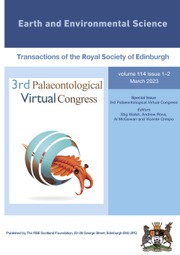Article contents
A review of the Carboniferous lungfish genus Ctenodus Agassiz, 1838 from the United Kingdom, with new data from an articulated specimen of Ctenodus interruptus Barkas, 1869
Published online by Cambridge University Press: 03 December 2013
Abstract
A revision of the Carboniferous lungfish genus Ctenodus is undertaken. Ctenodus is the longest-surviving genus of lungfish from the Carboniferous, and is the only one to cross the Lower–Upper Carboniferous boundary. Five species span the period, with species correlated to stage. Species are distinguished by differences in tooth plate morphology. Ridge number increases from the Tournaisian to the Moscovian, and the length to width ratio decreases. A new, almost complete articulated individual of C. interruptus allows identification of this species from pterygoid tooth plates and other characteristics. These, and new features of the postcranial skeleton, are described for the first time. Ctenodus retains primitive features of the skull roof, such as a pair of C-bones and retention of a D-bone; its contemporaries Conchopoma, Sagenodus and Straitonia show the derived condition of these features. Ctenodus retains primitive features of the lepidotrichia, which are distally segmented and bifurcated. However, it also shows the derived condition of the tail region in having a combined first and second dorsal fin: whether there was a separate caudal fin remains unknown.
- Type
- Articles
- Information
- Earth and Environmental Science Transactions of The Royal Society of Edinburgh , Volume 104 , Issue 2 , July 2013 , pp. 169 - 204
- Copyright
- Copyright © The Royal Society of Edinburgh 2013
References
6. References
- 12
- Cited by


